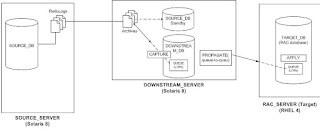ASMCMD [+DATA/PROD/ARCHIVELOG/2007_11_12] > ls
thread_1_seq_652.618.638445679
thread_1_seq_654.619.638466159
thread_1_seq_656.620.638466307
thread_1_seq_658.623.638467267
thread_1_seq_659.624.638467413
thread_1_seq_660.625.638467431
thread_2_seq_262.616.638416837
thread_2_seq_264.617.638445669
thread_2_seq_265.621.638467091
thread_2_seq_266.622.638467229
ASMCMD [+DATA/PROD/ARCHIVELOG/2007_11_12]
Notice that thread 1 (node 1) is missing sequences 653, 655 and 657. Similarly thread 2 is missing sequence#263.
Question is how to bring these missing archivelogs from ASM@primary cluster (they are still sitting on disk @primary)?
Solution: I use a 3-step process there
step 1: Use RMAN "copy" command to copy these to a cooked filesystem on the primary cluster
step 2: Scp the restored (copied) archivelogs to the standby cluster
step 3: Recover (automatic) standby database and supply the scp'ed archivelog under cooked FS.
First, query the ASM@primary to get the exact name/location of these archives --
ASMCMD [+FRA/PROD/ARCHIVELOG/2007_11_12] > ls
thread_1_seq_650.768.638416833
thread_1_seq_651.771.638416841
thread_1_seq_652.781.638445663
thread_1_seq_653.796.638465819
thread_1_seq_654.797.638466159
thread_1_seq_655.798.638466189
thread_1_seq_656.800.638466307
thread_1_seq_657.801.638466455
thread_2_seq_262.769.638416835
thread_2_seq_263.770.638416841
thread_2_seq_264.782.638445665
thread_2_seq_265.799.638466191
step 1: Execute the RMAN copy command (primary cluster). Set the env to the database first.
RMAN> copy archivelog '+FRA/prod/archivelog/2007_11_12/thread_2_seq_263.770.638416841' to '/u02/backup/PROD/thread_2_seq_263.770.638416841';
Starting backup at 12-NOV-07
using target database control file instead of recovery catalog
allocated channel: ORA_DISK_1
channel ORA_DISK_1: sid=1055 instance=PROD1 devtype=DISK
allocated channel: ORA_DISK_2
channel ORA_DISK_2: sid=1057 instance=PROD1 devtype=DISK
channel ORA_DISK_1: starting archive copy
input archive log thread=2 sequence=263 recid=1412 stamp=638416840
output filename=/u02/backup/PROD/thread_2_seq_263.770.638416841 recid=1426 stamp=638465672
channel ORA_DISK_1: archivelog copy complete, elapsed time: 00:00:02
Finished backup at 12-NOV-07
Starting Control File and SPFILE Autobackup at 12-NOV-07
piece handle=+FRA/prod/autobackup/2007_11_12/s_638465673.795.638465673 comment=NONE
Finished Control File and SPFILE Autobackup at 12-NOV-07
RMAN> copy archivelog '+FRA/PROD/ARCHIVELOG/2007_11_12/thread_1_seq_653.796.638465819' to '/u02/backup/PROD/thread_1_seq_653.796.638465819';
Starting backup at 12-NOV-07
using target database control file instead of recovery catalog
allocated channel: ORA_DISK_1
channel ORA_DISK_1: sid=1055 instance=PROD1 devtype=DISK
allocated channel: ORA_DISK_2
channel ORA_DISK_2: sid=1081 instance=PROD1 devtype=DISK
channel ORA_DISK_1: starting archive copy
input archive log thread=1 sequence=653 recid=1427 stamp=638465819
output filename=/u02/backup/PROD/thread_1_seq_653.796.638465819 recid=1435 stamp=638466707
channel ORA_DISK_1: archivelog copy complete, elapsed time: 00:00:02
Finished backup at 12-NOV-07
Starting Control File and SPFILE Autobackup at 12-NOV-07
piece handle=+FRA/prod/autobackup/2007_11_12/s_638466708.802.638466709 comment=NONE
Finished Control File and SPFILE Autobackup at 12-NOV-07
RMAN> copy archivelog '+FRA/PROD/ARCHIVELOG/2007_11_12/thread_1_seq_655.798.638466189' to '/u02/backup/PROD/thread_1_seq_655.798.638466189';
Starting backup at 12-NOV-07
using channel ORA_DISK_1
using channel ORA_DISK_2
channel ORA_DISK_1: starting archive copy
input archive log thread=1 sequence=655 recid=1430 stamp=638466189
output filename=/u02/backup/PROD/thread_1_seq_655.798.638466189 recid=1436 stamp=638466745
channel ORA_DISK_1: archivelog copy complete, elapsed time: 00:00:02
Finished backup at 12-NOV-07
Starting Control File and SPFILE Autobackup at 12-NOV-07
piece handle=+FRA/prod/autobackup/2007_11_12/s_638466746.803.638466747 comment=NONE
Finished Control File and SPFILE Autobackup at 12-NOV-07
RMAN> copy archivelog '+FRA/PROD/ARCHIVELOG/2007_11_12/thread_1_seq_657.801.638466455' to '/u02/backup/PROD/thread_1_seq_657.801.638466455';
Starting backup at 12-NOV-07
using channel ORA_DISK_1
using channel ORA_DISK_2
channel ORA_DISK_1: starting archive copy
input archive log thread=1 sequence=657 recid=1434 stamp=638466454
output filename=/u02/backup/PROD/thread_1_seq_657.801.638466455 recid=1437 stamp=638466777
channel ORA_DISK_1: archivelog copy complete, elapsed time: 00:00:02
Finished backup at 12-NOV-07
Starting Control File and SPFILE Autobackup at 12-NOV-07
piece handle=+FRA/prod/autobackup/2007_11_12/s_638466778.804.638466779 comment=NONE
Finished Control File and SPFILE Autobackup at 12-NOV-07
RMAN> quit
Recovery Manager complete.
total 47463696
-rw-r----- 1 oracle oinstall 32768 Nov 12 15:52 thread_1_seq_657.801.638466455
-rw-r----- 1 oracle oinstall 17920 Nov 12 15:52 thread_1_seq_655.798.638466189
-rw-r----- 1 oracle oinstall 15824384 Nov 12 15:51 thread_1_seq_653.796.638465819
-rw-r----- 1 oracle oinstall 1024 Nov 12 15:50 thread_2_seq_263.770.638416841
...
...
step2: Scp the restored archivelogs to the standby server (bcp1 is node 1 of our standby cluster)
thread_2_seq_263.770.638416841
thread_1_seq_653.796.638465819 100% 15MB 15.1MB/s 00:01
thread_1_seq_655.798.638466189 100% 18KB 17.5KB/s 00:00
thread_1_seq_657.801.638466455
PROD1_SQL > recover automatic standby database;
ORA-00279: change 98980021976 generated at 11/12/2007 02:00:34 needed for thread 2
ORA-00289: suggestion : +DATA/prod/2_263_631792716.dbf
ORA-00280: change 98980021976 for thread 2 is in sequence #263
ORA-00278: log file '+DATA/prod/2_262_631792716.dbf' no longer needed for this recovery
Specify log: {
/u02/backup/PROD/thread_2_seq_263.770.638416841
RA-00279: change 98980621191 generated at 11/12/2007 10:01:02 needed for thread 1
ORA-00289: suggestion : +DATA/prod/1_653_631792716.dbf
ORA-00280: change 98980621191 for thread 1 is in sequence #653
ORA-00278: log file '+DATA/prod/1_653_631792716.dbf' no longer needed for this recovery
ORA-00308: cannot open archived log '+DATA/prod/1_653_631792716.dbf'
ORA-17503: ksfdopn:2 Failed to open file +DATA/prod/1_653_631792716.dbf
ORA-15173: entry '1_653_631792716.dbf' does not exist in directory 'prod'
Specify log: {
/u02/backup/PROD/thread_1_seq_653.796.638465819
ORA-00279: change 98980621191 generated at 11/12/2007 02:00:40 needed for thread 2
ORA-00289: suggestion : +DATA/prod/2_264_631792716.dbf
ORA-00280: change 98980621191 for thread 2 is in sequence #264
Specify log: {
ORA-00279: change 98980621195 generated at 11/12/2007 10:01:04 needed for thread 2
ORA-00289: suggestion : +DATA/prod/2_265_631792716.dbf
ORA-00280: change 98980621195 for thread 2 is in sequence #265
ORA-00278: log file '+DATA/prod/2_264_631792716.dbf' no longer needed for this recovery
Specify log: {
/u02/backup/PROD/thread_2_seq_265.799.638466191
ORA-00279: change 98981521197 generated at 11/12/2007 15:36:59 needed for thread 1
ORA-00289: suggestion : +DATA/prod/1_654_631792716.dbf
ORA-00280: change 98981521197 for thread 1 is in sequence #654
ORA-00278: log file '/u02/backup/PROD/thread_1_seq_653.796.638465819' no longer needed for this recovery
Specify log: {
ORA-00279: change 98981522036 generated at 11/12/2007 15:42:38 needed for thread 1
ORA-00289: suggestion : +DATA/prod/1_655_631792716.dbf
ORA-00280: change 98981522036 for thread 1 is in sequence #655
ORA-00278: log file '+DATA/prod/1_654_631792716.dbf' no longer needed for this recovery
Specify log: {
/u02/backup/PROD/thread_1_seq_655.798.638466189
ORA-00279: change 98981522129 generated at 11/12/2007 15:43:09 needed for thread 1
ORA-00289: suggestion : +DATA/prod/1_656_631792716.dbf
ORA-00280: change 98981522129 for thread 1 is in sequence #656
ORA-00278: log file '/u02/backup/PROD/thread_1_seq_655.798.638466189' no longer needed for this recovery
Specify log: {
ORA-00279: change 98981522138 generated at 11/12/2007 15:43:11 needed for thread 2
ORA-00289: suggestion : +DATA/prod/2_266_631792716.dbf
ORA-00280: change 98981522138 for thread 2 is in sequence #266
ORA-00278: log file '/u02/backup/PROD/thread_2_seq_265.799.638466191' no longer needed for this recovery
Specify log: {
/u02/backup/PROD/thread_2_seq_266.806.638467227
ORA-00279: change 98981577931 generated at 11/12/2007 15:45:07 needed for thread 1
ORA-00289: suggestion : +DATA/prod/1_657_631792716.dbf
ORA-00280: change 98981577931 for thread 1 is in sequence #657
ORA-00278: log file '+DATA/prod/1_656_631792716.dbf' no longer needed for this recovery
Specify log: {
/u02/backup/PROD/thread_1_seq_657.801.638466455
ORA-00279: change 98981578237 generated at 11/12/2007 15:47:34 needed for thread 1
ORA-00289: suggestion : +DATA/prod/1_658_631792716.dbf
ORA-00280: change 98981578237 for thread 1 is in sequence #658
ORA-00278: log file '/u02/backup/PROD/thread_1_seq_657.801.638466455' no longer needed for this recovery
Specify log: {
cancel
Media recovery cancelled.
PROD1_SQL > recover managed standby database using current logfile disconnect from session;
Media recovery complete.
This completes the recovery process for the standby database and fills in the gaps.

